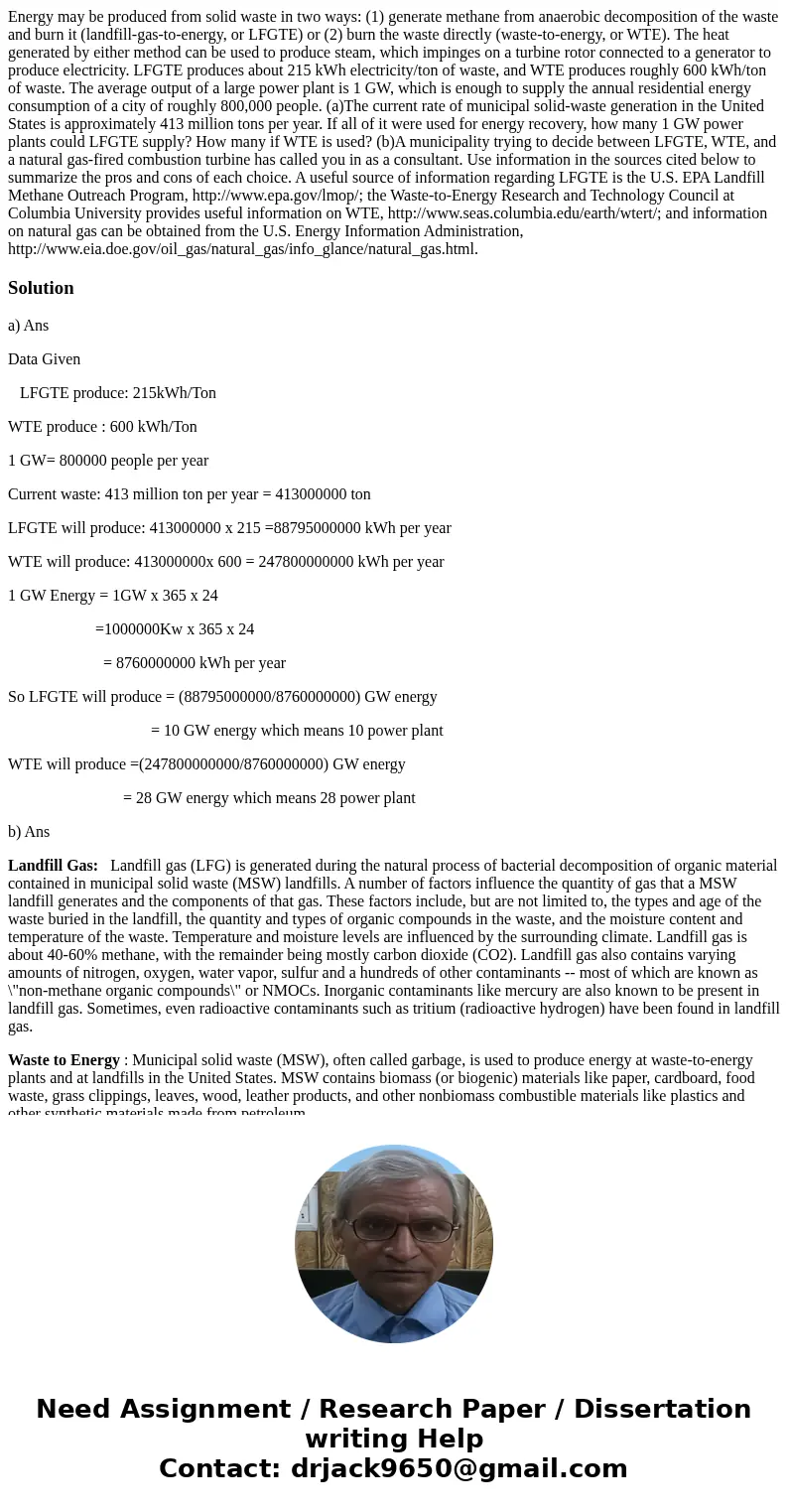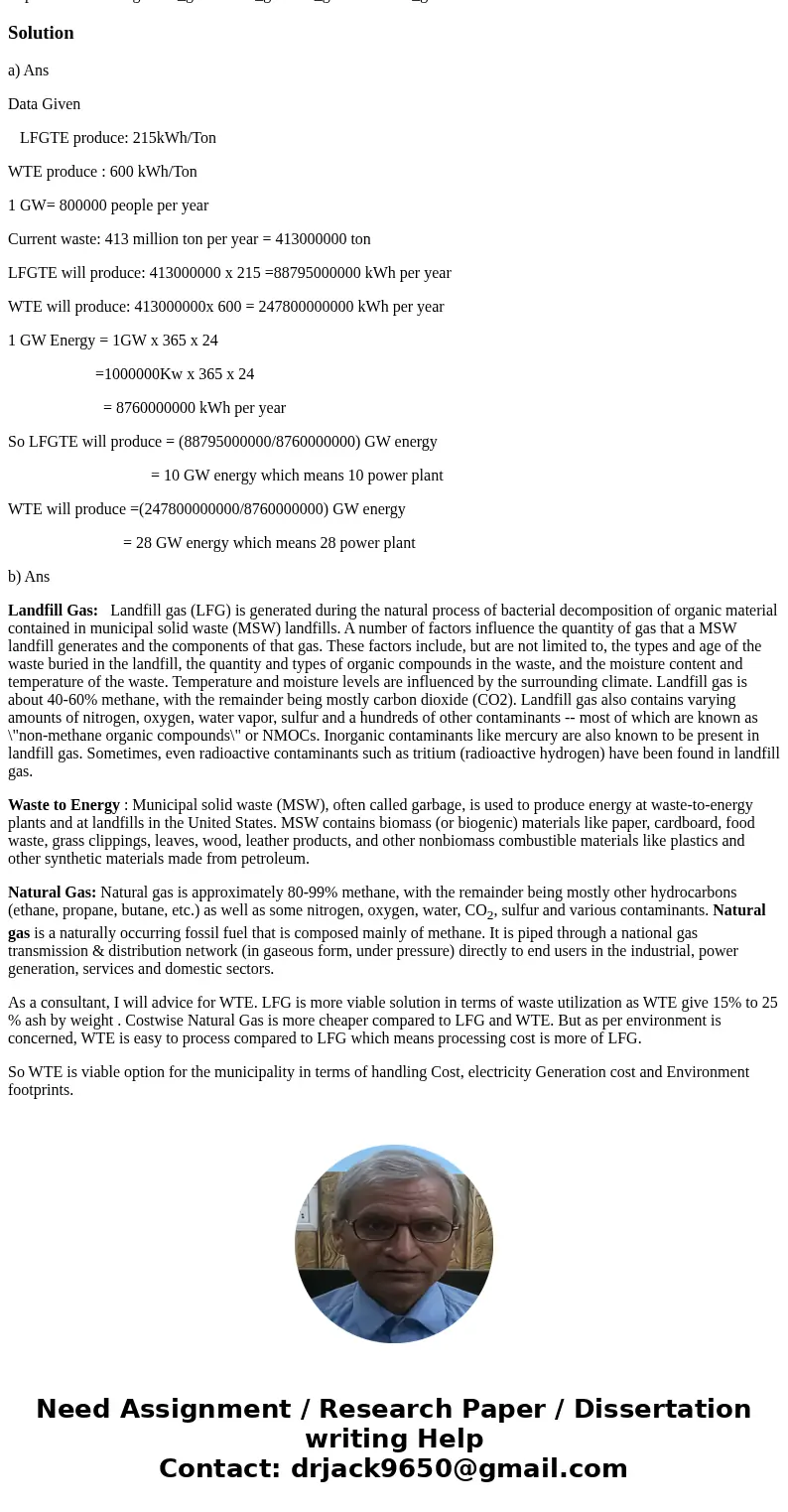Energy may be produced from solid waste in two ways 1 genera
Energy may be produced from solid waste in two ways: (1) generate methane from anaerobic decomposition of the waste and burn it (landfill-gas-to-energy, or LFGTE) or (2) burn the waste directly (waste-to-energy, or WTE). The heat generated by either method can be used to produce steam, which impinges on a turbine rotor connected to a generator to produce electricity. LFGTE produces about 215 kWh electricity/ton of waste, and WTE produces roughly 600 kWh/ton of waste. The average output of a large power plant is 1 GW, which is enough to supply the annual residential energy consumption of a city of roughly 800,000 people. (a)The current rate of municipal solid-waste generation in the United States is approximately 413 million tons per year. If all of it were used for energy recovery, how many 1 GW power plants could LFGTE supply? How many if WTE is used? (b)A municipality trying to decide between LFGTE, WTE, and a natural gas-fired combustion turbine has called you in as a consultant. Use information in the sources cited below to summarize the pros and cons of each choice. A useful source of information regarding LFGTE is the U.S. EPA Landfill Methane Outreach Program, http://www.epa.gov/lmop/; the Waste-to-Energy Research and Technology Council at Columbia University provides useful information on WTE, http://www.seas.columbia.edu/earth/wtert/; and information on natural gas can be obtained from the U.S. Energy Information Administration, http://www.eia.doe.gov/oil_gas/natural_gas/info_glance/natural_gas.html.
Solution
a) Ans
Data Given
LFGTE produce: 215kWh/Ton
WTE produce : 600 kWh/Ton
1 GW= 800000 people per year
Current waste: 413 million ton per year = 413000000 ton
LFGTE will produce: 413000000 x 215 =88795000000 kWh per year
WTE will produce: 413000000x 600 = 247800000000 kWh per year
1 GW Energy = 1GW x 365 x 24
=1000000Kw x 365 x 24
= 8760000000 kWh per year
So LFGTE will produce = (88795000000/8760000000) GW energy
= 10 GW energy which means 10 power plant
WTE will produce =(247800000000/8760000000) GW energy
= 28 GW energy which means 28 power plant
b) Ans
Landfill Gas: Landfill gas (LFG) is generated during the natural process of bacterial decomposition of organic material contained in municipal solid waste (MSW) landfills. A number of factors influence the quantity of gas that a MSW landfill generates and the components of that gas. These factors include, but are not limited to, the types and age of the waste buried in the landfill, the quantity and types of organic compounds in the waste, and the moisture content and temperature of the waste. Temperature and moisture levels are influenced by the surrounding climate. Landfill gas is about 40-60% methane, with the remainder being mostly carbon dioxide (CO2). Landfill gas also contains varying amounts of nitrogen, oxygen, water vapor, sulfur and a hundreds of other contaminants -- most of which are known as \"non-methane organic compounds\" or NMOCs. Inorganic contaminants like mercury are also known to be present in landfill gas. Sometimes, even radioactive contaminants such as tritium (radioactive hydrogen) have been found in landfill gas.
Waste to Energy : Municipal solid waste (MSW), often called garbage, is used to produce energy at waste-to-energy plants and at landfills in the United States. MSW contains biomass (or biogenic) materials like paper, cardboard, food waste, grass clippings, leaves, wood, leather products, and other nonbiomass combustible materials like plastics and other synthetic materials made from petroleum.
Natural Gas: Natural gas is approximately 80-99% methane, with the remainder being mostly other hydrocarbons (ethane, propane, butane, etc.) as well as some nitrogen, oxygen, water, CO2, sulfur and various contaminants. Natural gas is a naturally occurring fossil fuel that is composed mainly of methane. It is piped through a national gas transmission & distribution network (in gaseous form, under pressure) directly to end users in the industrial, power generation, services and domestic sectors.
As a consultant, I will advice for WTE. LFG is more viable solution in terms of waste utilization as WTE give 15% to 25 % ash by weight . Costwise Natural Gas is more cheaper compared to LFG and WTE. But as per environment is concerned, WTE is easy to process compared to LFG which means processing cost is more of LFG.
So WTE is viable option for the municipality in terms of handling Cost, electricity Generation cost and Environment footprints.


 Homework Sourse
Homework Sourse